Related Research Articles
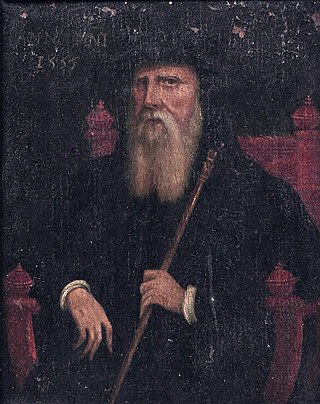
John Russell, 1st Earl of Bedford was an English royal minister in the Tudor era. He served variously as Lord High Admiral and Lord Privy Seal. Among the lands and property he was given by Henry VIII after the Dissolution of the Monasteries, were the Abbey and town of Tavistock, and the area that is now Covent Garden. Russell is the ancestor of all subsequent Earls and Dukes of Bedford and Earls Russell, including John Russell, Prime Minister of the United Kingdom, and philosopher Bertrand Russell.
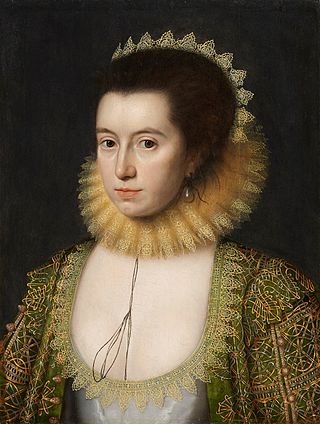
Lady Anne Clifford, Countess of Dorset, Pembroke and Montgomery, suo jure 14th Baroness de Clifford was an English peeress. In 1605 she inherited her father's ancient barony by writ and became suo jure 14th Baroness de Clifford. She was a patron of literature and as evidenced by her diary and many letters was a literary personage in her own right. She held the hereditary office of High Sheriff of Westmorland which role she exercised from 1653 to 1676.

Katherine Howard, Countess of Suffolk was an English court office holder who served as lady-in-waiting to the queen consort of England, Anne of Denmark.

Edward Russell, 3rd Earl of Bedford was an English nobleman and politician.

William Russell, 1st Duke of Bedford KG PC was an English nobleman and politician who sat in the House of Commons from 1640 until 1641 when he inherited his Peerage as 5th Earl of Bedford and removed to the House of Lords. He fought in the Parliamentarian army and later defected to the Royalists during the English Civil War.
Cecil House refers to two historical mansions on The Strand, London, in the vicinity of the Savoy. The first was a 16th-century house on the north side, where the Strand Palace Hotel now stands. The second was built in the early 17th century on the south side nearly opposite, where Shell Mex House stands today.

John Harington, 1st Baron Harington of Exton in Rutland, was an English courtier and politician.
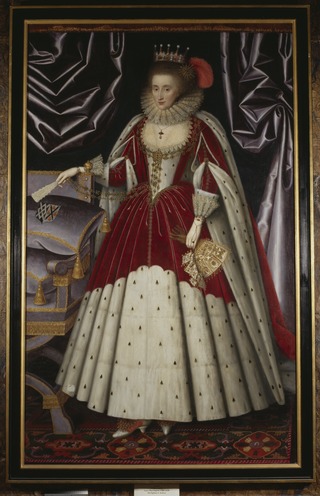
Lucy Russell, Countess of Bedford was a major aristocratic patron of the arts and literature in the Elizabethan and Jacobean eras, the primary non-royal performer in contemporary court masques, a letter-writer, and a poet. She was an adventurer (shareholder) in the Somers Isles Company, investing in Bermuda, where Harrington Sound is named after her.
Jean Ker, Countess of Roxburghe, néeDrummond (c.1585–1643) was a Scottish courtier, serving Anne of Denmark in Scotland and England.

Elizabeth Hastings, later Countess of Worcester was a noblewoman born in Scotland to Francis Hastings, 2nd Earl of Huntingdon, and Catherine Pole. On 16 December 1571 at Whitehall Palace in a triple wedding with Edward de Vere, 17th Earl of Oxford and bride, Anne Cecil, and Edward Sutton, 4th Baron Dudley and bride, Mary Howard, she married Sir Edward Somerset, 4th Earl of Worcester, son of Sir William Somerset, 3rd Earl of Worcester and Christian North.
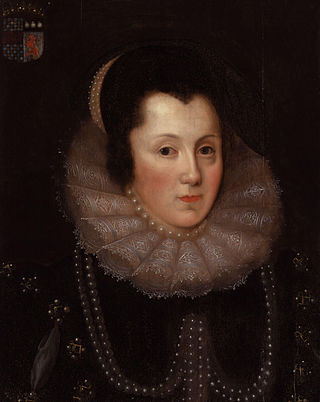
Margaret Clifford, Countess of Cumberland was an English noblewoman and maid of honor to Elizabeth I. Lady Margaret was born in Exeter, England to Francis Russell, 2nd Earl of Bedford and Margaret St John.
Simon Basil was an English surveyor or architect, who held the post of Surveyor of the King's Works, 1606-15.
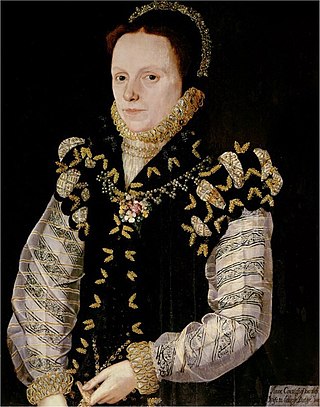
Anne Dudley, Countess of Warwick was an English noblewoman, and a lady-in-waiting and close friend of Elizabeth I. She was the third wife of Ambrose Dudley, 3rd Earl of Warwick.
Mary (Dudley) Sutton, Countess of Home (1586–1644), was a landowner, living in England and Scotland.
Bridget Markham (1579–1609), was a courtier to Anne of Denmark and subject of poems.
Theodosia Harington, Lady Dudley was an English aristocrat who was abandoned by her husband, but maintained connections at court through her extensive family networks.
Sir Henry Harington of Bagworth and Baltinglass, English and Irish landowner and soldier, known for his defeat at Arklow in 1599.

Anne Killigrew was a Lady in Waiting to Queen Henrietta Maria, and the first wife of George Kirke who was Groom of the Chamber to Charles I of England.

Anne Keilway was an English courtier.

Anne of Denmark (1574–1619) was the wife of James VI and I, and queen consort of Scotland from 1589, and queen consort of England and Ireland from the union of the Scottish and English crowns in 1603 until her death on 2 March 1619 at Hampton Court. She was buried at Westminster Abbey on 13 May.
References
- ↑ Manolo Guerci. London's Golden Mile: The Great Houses of the Strand (Yale, 2021), p. 105.
- ↑ James Howell, Londinopolis (London, 1657), p. 349.
- ↑ Manolo Guerci. London's Golden Mile: The Great Houses of the Strand (Yale, 2021), p. 108.
- ↑ E.J. Burford, Wits, Wenchers and Wantons: London's Low Life: Covent Garden in the Eighteenth Century (London, 1986), pp. 1–3.
- ↑ Gladys Scott Thomson, Life In A Noble Household 1641-1700 (London, 1950), p. 37.
- ↑ Manolo Guerci. London's Golden Mile: The Great Houses of the Strand (Yale, 2021), p. 110.
- ↑ See, 'Plan of Bedford House around the year 1690', external links.
- ↑ Marion O'Connor, 'Godly Patronage: Lucy Harington Russell, Countess of Bedord', Johanna Harris & Elizabeth Scott-Baumann The Intellectual Culture of Puritan Women, 1558–1680 (Palgrave, 2010), p. 71.
- ↑ Lesley Lawson, Out of the Shadows: The Life of Lucy, Countess of Bedford (London, 2007), p. 21.
- ↑ Manolo Guerci. London's Golden Mile: The Great Houses of the Strand (Yale, 2021), p. 110.
- ↑ Manolo Guerci, 'Salisbury House in London, 1599-1694: The Strand Palace of Sir Robert Cecil', Architectural History, 52 (2009), pp. 31-78.
- ↑ Peter Cunningham, A Handbook for London: Past and Present, vol. 1 (London, 1849), pp. 71-2.
- ↑ Gladys Scott Thomson, Life In A Noble Household 1641-1700 (London, 1950), p. 239.
- ↑ Gladys Scott Thomson, Life In A Noble Household 1641-1700 (London, 1950), p. 38
- ↑ Willis's Current Notes, vol. 5 no. 51 (March 1855), pp. 17-8 citing an engraving by Bernard Lens of the return of William III in 1690.
- ↑ Jessica L. Malay, Anne Clifford's Autobiographical Writing, 1590-1676 (Manchester, 2018), p. 250.
- ↑ Joanna Moody, Correspondence of Lady Cornwallis Bacon (Cranbury NJ, 2003) p. 84.
- ↑ Manolo Guerci. London's Golden Mile: The Great Houses of the Strand (Yale, 2021), p. 112.
- ↑ Marion O'Connor, 'Godly Patronage', Johanna Harris & Elizabeth Scott-Baumann, The Intellectual Culture of Puritan Women (Palgrave, 2011), p. 78.
- ↑ Jessica L. Malay, Anne Clifford's Autobiographical Writing, 1590-1676 (Manchester, 2018), pp. 49, 81.
- ↑ Jessica L. Malay, Anne Clifford's Autobiographical Writing, 1590-1676 (Manchester, 2018), p. 81.
- ↑ Marion O'Connor, 'Godly Patronage', Johanna Harris & Elizabeth Scott-Baumann, The Intellectual Culture of Puritan Women (Palgrave, 2011), p. 75.
- ↑ HMC Rutland, vol. 4 (London, 1905), p. 526.
- ↑ Manolo Guerci. London's Golden Mile: The Great Houses of the Strand (Yale, 2021), p. 110.
- ↑ Manolo Guerci. London's Golden Mile: The Great Houses of the Strand (Yale, 2021), p. 111.
- ↑ Gladys Scott Thomson, Life In A Noble Household 1641-1700 (London, 1950), p. 56.
- ↑ Gladys Scott Thomson, Life In A Noble Household 1641-1700 (London, 1950), pp. 70-71.